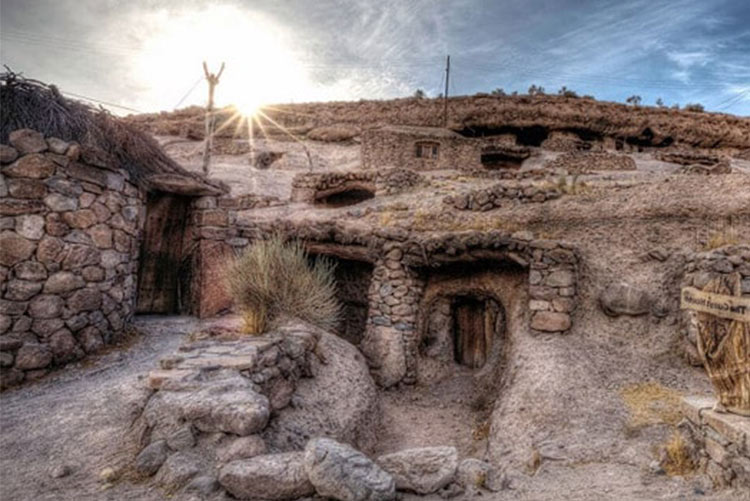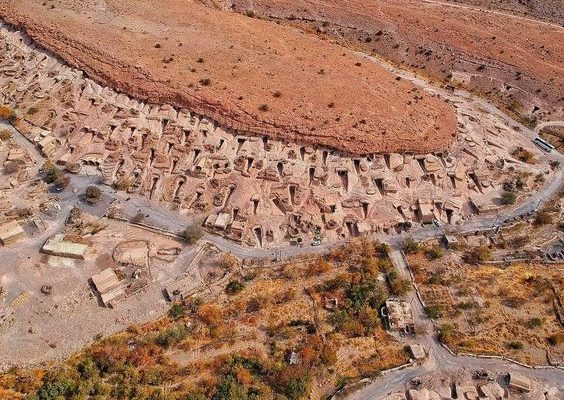Meymand is a very ancient village which is located near Shahr-e Babak city in Kerman Province, Iran. Meymand is believed to be a primary human residence in the Iranian Plateau, dating back to 12,000 years ago. Many of the residents live in the 350 hand-dug houses amid the rocks, some of which have been inhabited for as long as 3,000 years. Stone engravings nearly 10,000 years old are found around the village .On 4 July 2015, the village was added to the UNESCO World Heritage Sites list.

Wherever you step in vast Iran, you will hear the story of ancient civilizations that amaze you. Places that, if we take a little more care, can become one of the largest tourism hubs in the world. Meanwhile, one of the most popular and amazing tourist attractions in the world are the rocky villages. In addition to Iran, there are rocky villages in the United States (Dakota village) and Turkey (Cappadocia village). However, many people know the only famous village of Kandovan as the rock village of Iran. But the number of rock villages in Iran is more than one village, From the cunning village of Dastkand in Tabriz (about the same age as Kandovan village) to Meymand in Kerman, there are other examples of rock villages in our country.
Introduction of Meymand of Kerman
In the heart of the mountains of Kerman province and near the city of Babak, there is the village of Dastkandi, whose houses are built without bricks, mud and bricks. An amazing village that still lives after many years.
Meymand is one of the largest villages in the world that has won the Melina Mercury International Award. There are many narrations about the meaning and method of naming this village after Meymand.
Some believe that the people of Meymand village in Fars province changed the name of this area to Meymand after migrating to Kerman. Others say that Meymand means may (wine) and mand (drunk). They believe that the men of this village drank wine and dug the houses of the village while drunk.
However, no one knows who and for what purpose dug houses in the heart of the mountain. But it is no secret that Meymand is one of the most mysterious villages in Iran.
It is interesting to know that Meymand village of Kerman has been registered in UNESCO in 1394.
History of Meymand
The exact history of the mysterious village of Meymand is still unknown to locals and archaeologists. However, based on the latest excavations of pottery pieces, archaeologists estimate the history of Meymand village to be 2 to 3 thousand years ago. A village that was probably built during the Parthian period.
But the rock carvings around Meymand village are a longer historical evidence. A history that shows the presence of humans thousands of years before the Parthian reign. After many years of building this village, no one knows the reason and how to build these houses; But the strength and stability of this building after many years shows the unique intelligence and architectural art of the people of that time.
People who have been able to build hand-built houses without the need for bricks, mud and bricks, and simply by digging mountains. The defensive fortifications and the way these houses were built in the heart of the mountain have made the people of Meymand safe from the attacks of the enemies.

Architecture of Meymand
Meymand rocky village has 406 houses or Kicheh. The keychains are generally made in 5 different floors and on top of each other. It is interesting to know that each of the kits has different rooms inside. So that the number of rooms in this village reaches 2560.
After passing through the entrance of the houses to the living room, several rooms and stables were reached. But each house in Meymand village has a different plan and rooms. The small and short entrances of the houses and their unique architecture make each of these kits act as thermal insulation.
So that the houses of this village are cool in summer and warm in winter. In addition, the high resistance of Meymand village against fire is another advantage of this rocky village.
There are small and large niches in Meymand keychains that are covered by curtains. From dishes, clothes and beds to boxes and lights are kept in these niches. Also, locals use stoves called didons for heating and cooking.
Upon entering Meymand houses, you will notice the black roof of the houses. These blacks are the result of lighting the stove in the kitchen. But this has led to a significant increase in the life of the kits.
It is interesting to know that Meymand village also has a mosque, Hosseinieh, school, bath and fire temple.
What is the job of the people of Meymand village?
The people of Meymand village are nomads who live in this village in winter. The good climate of the region and the existence of Meymand plain around this village has caused the local people to live in the plain during the warm seasons.
On the other hand, the unique architecture of Meymand village houses has made it a safe haven and residence for local people in the cold seasons of the year. The occupation of the people of Meymand village is agriculture and animal husbandry. In addition, Meymand women are engaged in basket weaving, kilim weaving, financial felt and carpet weaving.
The people of Meymand village are still loyal to the customs of their ancestors. From holding religious and historical ceremonies such as breastfeeding to their local dialect (a combination of Sassanid Pahlavi words) is still common among the people of Meymand.
Location of Meymand
Meymand village is located in an area of 420 square kilometers and at an altitude of 2240 meters above sea level. Various medicinal plants such as thyme, lavender, sorrel, rhubarb, March, etc. grow around the village of Meymand.
There is a vast plain and countless mountains near Meymand village. Walking in this area, you will see many fruit trees and animals. From snakes, turtles and hedgehogs to wild animals such as foxes and antelopes, etc. live in this pristine and beautiful area. Meymand village of Kerman is another example of rock villages in the world; But with the difference that life in Meymand is still going on. The experience of living in a rock house for thousands of years can definitely be enjoyable.



